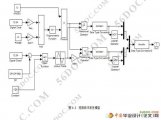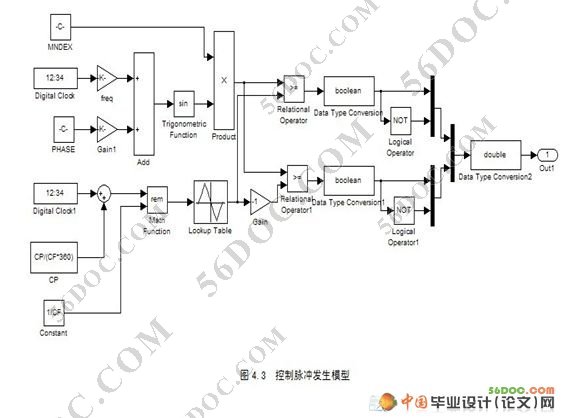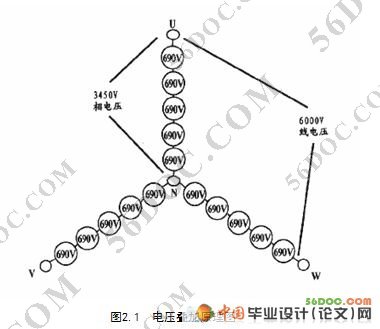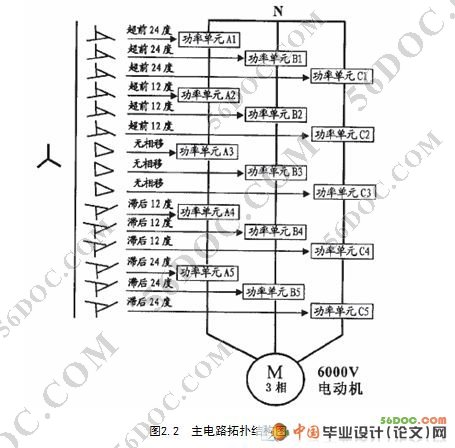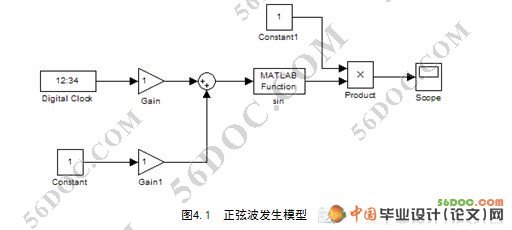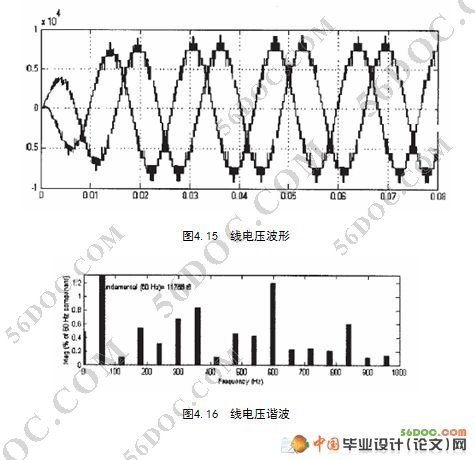基于MATLAB的变频器的仿真研究(论文)
来源:56doc.com 资料编号:5D3883 资料等级:★★★★★ %E8%B5%84%E6%96%99%E7%BC%96%E5%8F%B7%EF%BC%9A5D3883
资料以网页介绍的为准,下载后不会有水印.资料仅供学习参考之用. 密 保 惠 帮助
资料介绍
摘要
变频调速技术已经成为节能和提高产品质量的有效措施。低压变频器技术已经成熟,但高压变频器目前还没有一个统一的拓扑结构,在众多解决方案中单元串联多电平高压变频器以其在输入与输出谐波、效率和输入功率因数等方面明显的优势,在实际应用领域中占有一席之地,特别在风机、泵类的行业具有良好的市场前景。
本文主要介绍单元串联多电平6KV高压变频器的仿真研究。具体的工作主要有以下两个方面:
⒈概述了高压变频器的国内外技术发展及趋势,对高压变频器各种类型的优缺点进行了分析,并通过该分析确定了单元串联多电平高压变频器为本设计的可行方案。阐述了单元串联多电平移相式PWM电压源型变频器原理,通过对原理的阐述,进一步透彻的掌握单元串联多电平高压变频器的内部特性。
⒉基于MATLAB/Simulink对6KV高压变频器进行建模与仿真研究,完成了对脉冲信号、单元电路、一相、三相和变频器系统的建模工作,并通过仿真,证明了单元串联多电平高压变频器在消除谐波问题上具有很大的优势。由仿真电流波形可以看出,在没有专门的滤波电路的情况下,其电流波形的正弦度已非常高,变频器的线电压共有21个阶梯,其正弦度比相电压更好,变频器的线电压谐波含量非常低,其含量最高的为10次谐波,其幅值为基波的1.19606%。
关键词:单元串联,多电平,高压,MATLAB/Simulink
Simulation Research of Frequency Converter
Based on MATLAB/Simulink
Abstract
The technology of frequency conversion and velocity adjustment has already become an effective method of both saving energy and improving product quality.The low-voltage frequency converter technology is already mature,but the high-voltage converter has not got a universal topology structure at present.Among the numerous solutions,cell series multi-level high-voltage frequency converter technology,depending on its obvious advantages in input and output harmonic,efficiency,input power factors etc,has occupied a share in market,especially,it has good market prospect in fan and pump industries.
This report mainly introduces the simulation research of cell series multi-level 6KV HVF(high voltage frequency).The concrete content consists of the following aspects:
⒈The development and trend of HVF technology,the requirements both in domestic and abroad market for HVF are reviewed.The advantages and disadvantages of different HVF types are analyzed in detail,and therefore,the scheme design is proposed based on this analysis.The basic principle of cell series multi-1evel PWM converter is described here.The description thoroughly illustrates the internal traits of cell series multi-level HVF.
⒉Based on MATLAB/Simulink,the modeling and simulation research of 6KV complete the modeling of the pulse signal,cell circuit,one-phase,three-phase and the frequency converter system.By simulation research,it is proved that the cell series multi-level HVF has got great superiority on eliminating harmonics.Shown by the simulation current waveform,without special filtrating circuit,the sine of its current waveform is already very high. The line voltage of the frequency changer owns 21 steps,and its sine value is better than phase-voltage,also the harmonic content of the frequency converter line voltage is very low,which the largest value is 10 harmonic waves,its amplitude value counts 1.19606% of a fundamental wave.
Key words:cell series, multi-level, high voltage , MATLAB/Simulink
毕业设计研究工作
高压变频器的开发是一项复杂的项目,其主要内容包括变频器的控制系统和变频器主电路的设计两大部分,它涉及到电机控制理论,多CPU运行,现场总线,大规模可编程逻辑电路,通信协议,电力电子技术等,是多学科、高技术的综合。从方案的生成到产品的调试直至产品的应用是一个较长的开发周期,需要大量的人力、物力。本次设计主要在于相关的高压变频器的仿真研究。完成的具体内容是:对整个高压变频器以及调速系统进行仿真研究,变频器模型的建立,包括控制脉冲模型、三相电源模型、功率单元模型、一相模型以及变频器的模型。然后对各个模型进行仿真和试验数据分析。
目 录 23700字
摘要 III
Abstract IV
第1章 绪论 - 1 -
1.1 高压变频器概述 - 1 -
1.1.1高压变频器的现状及发展趋势 - 1 -
1.1.2高压变频器的分类及各自特点 - 2 -
1.2 高压变频器系统具有的意义 - 5 -
1.3 毕业设计研究工作 - 6 -
第2章 单元串联多电平电压源型变频器 - 7 -
2.1 工作原理 - 7 -
2.2 整流单元 - 8 -
2.3 功率单元 - 10 -
2.4 多电平相移式PWM控制 - 11 -
2.5 高压变频器对电动机的影响分析 - 12 -
第3章 仿真工具MATLAB/Simulink简介 - 14 -
3.1 MATLAB简介 - 14 -
3.1.1MATLAB的特点及优势 - 15 -
3.1.2MATLAB的应用领域 - 15 -
3.2 Simulink简介 - 16 -
3.2.1simulink的特点 - 17 -
3.2.2Simulink的启动 - 17 -
3.2.3Simulink的模块库介绍 - 17 -
第4章 利用MATLAB/Simulink对高压变频器进行建模与仿真 - 24 -
4.1 脉冲电路模型的建立 - 24 -
4.1.1参考波正弦波模型 - 24 -
4.1.2载波三角波模型 - 25 -
4.1.3控制脉冲模型 - 25 -
4.1.4控制脉冲模块的封装 - 27 -
4.2 单个功率单元模型的建立与仿真 - 31 -
4.2.1三相交流电源的模型建立及封装 - 32 -
4.2.2三相交流电源内部参数的确定 - 33 -
4.2.3功率单元的仿真 - 34 -
4.3 单相仿真 - 35 -
4.3.1一相电路模型说明及参数设置 - 36 -
4.3.2带负载单相仿真 - 37 -
4.4 变频器仿真 - 38 -
第5章 结束语 - 40 -
参考文献 - 42 -
致谢 - 43 -
|
